Don't wanna be here? Send us removal request.
Text
TB2-WEEK 10: BLOG 10- New Distribution Models: Impact of Digital.
As mentioned a few blogs ago distribution is the act of transferring the rights of selling the film to other platforms, which in turn sells the film to the consumers. But with the advancement of technology, more and more platforms are available as a choice for companies. Netflix and Amazon are news means of distribution, in fact the impact of digital age on the distribution of films are so profound that there are even digital exclusives available only on movies distribution platforms like Netflix.
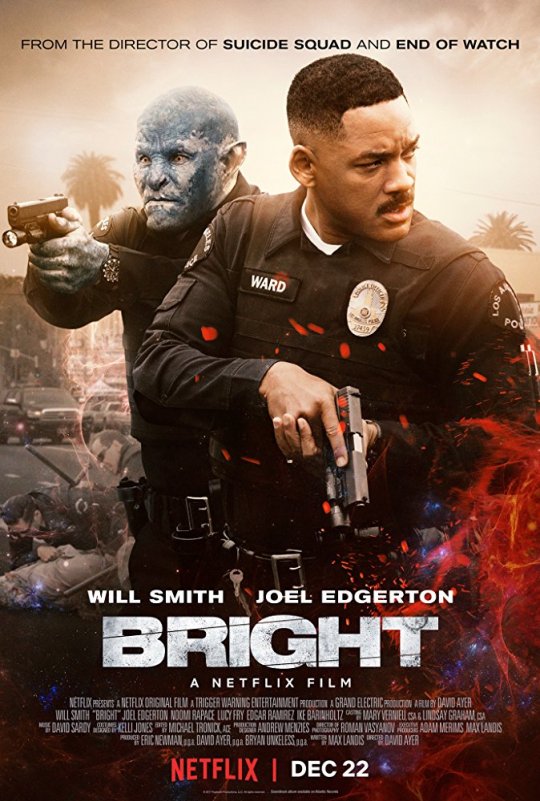
(IMDB, 2017)
One such example would be the 2017 film; Bright. It is available exclusively on Netflix, even though it has negative reviews it is still one of the most streamed film on the site (Mashable, 2017).
And this is just the tip of the iceberg, as more and more platforms develops, films would slowly move towards the more popular sources as most production companies’s ultimate goal is to have maximum audiences coverage when it comes to their distribution, as mentioned in previous blogs.
References
IMDB, 2017. Bright (2017). [online] Available at: <http://www.imdb.com/title/tt5519340/> [Accessed 25 March 2018]
MashableUK, 2017. Poor Will Smith! Critics tore apart Netflix's first hopeful blockbuster, 'Bright'. [online] Available at: <https://mashable.com/2017/12/22/bright-review-roundup/#USD7KujNriqM> [Accessed 25 March 2018]
0 notes
Text
TB2-WEEK 9: BLOG 9- BBC News Reporting.
This week’s theme is about news reporting, in addition to the news values (Digital Third Coast, 2018), news agencies would need to relay the news to the public, which is when news reported come into play.
And different news agencies would have a different way of reporting the same event. An example would be Brexit and how different newspaper would have different suggestive headlines. In this comparison The Sun and The Times are chosen, both with headlines from the same month.
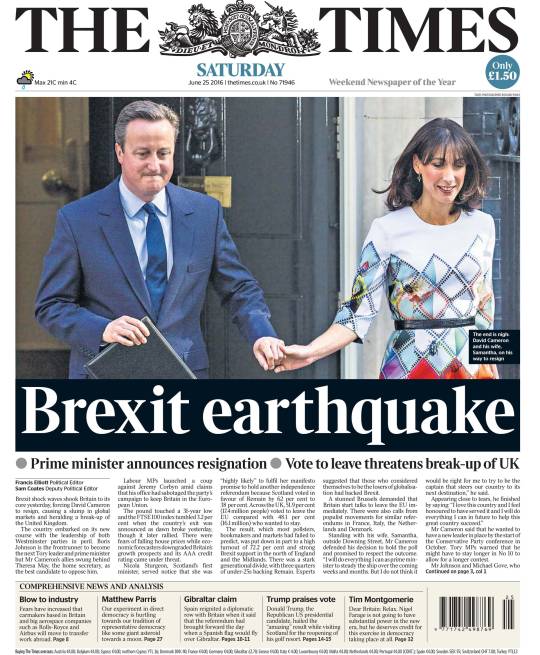
(The Times, 2016)
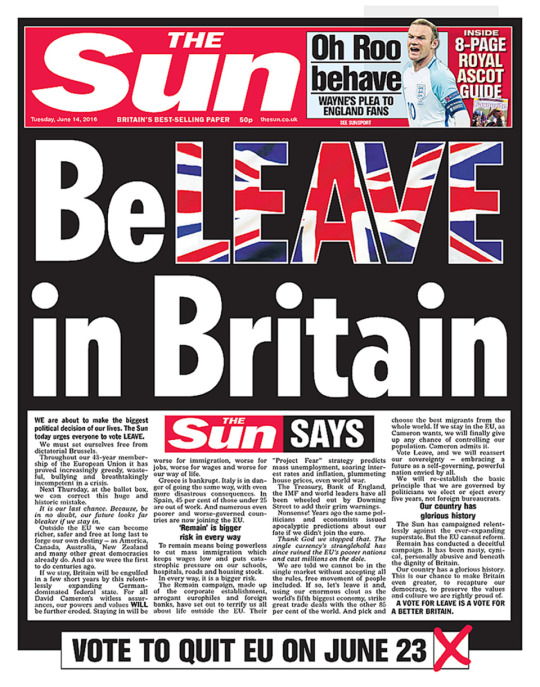
(The Sun, 2016)
Obviously The Sun is in favour of the UK leaving EU while the Guardian describe the whole ordeal as an “earthquake”, which is quite a strong word.
Thus we could see that different news sources might sometimes include their own opinion which would affect the presentation of the news, thus resulting in biased opinions instead of genuine news reporting.
References:
The Sun, 2016. BeLEAVE in Britain, The Sun, 14 June, p1.
The Guardian, 2016. Brexit Eartquake, The Guardian, 25 June, p1.
0 notes
Text
TB2-WEEK 8: BLOG 8- Multiculturalism and the Media
Multiculturalism, the reason why countries have different religions, different kinds of races and also different values. Multiculturalism is basically the idea of having more than one culture within the society (BBC, 2004). Examples are seen everywhere today, United States celebrating Chinese New Year, China celebrating Christmas, etc. These are all because of our increased tolerance towards others.
Thus we could see the media changing it’s course to adapt to the new sets of values. As society develops, so does the laws and individuals’perception of others, this is demonstrated by the Equality Act which allow equal opportunities for individuals from different cultures (EHRC, 2017). Thus the media industry would also need to adjust it’s policies, gone are the days television presenters could say racial slurs without consequences.
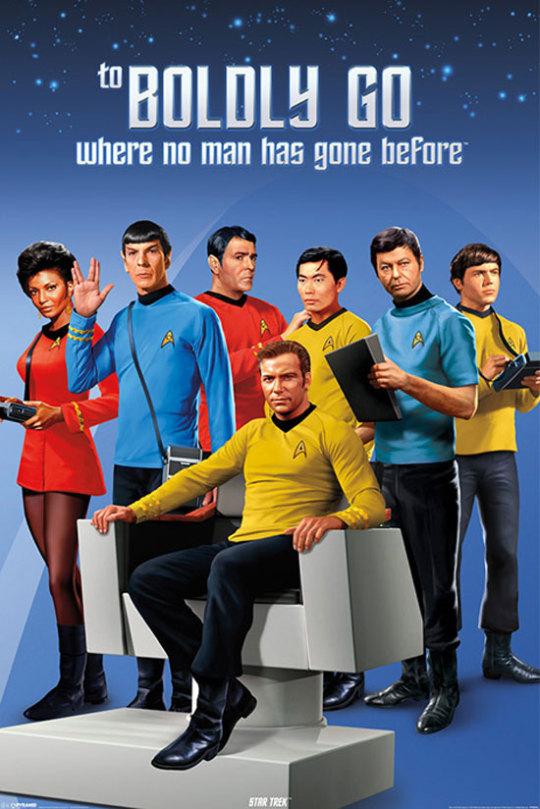
(IMDB, 2018)
An example of a multilateral film is the original Star Trek, which features multiple lead characters from different culture and races (IMDB, 2018). To include a diverse cast is bold, especially during the time of the series’ release, nonetheless it has influences many other films and television series to include casts with different cultural background (BHC, 2016).
But of course there is always the argument of whether or not employing actors that are of different race, even when it might not fit the settings of the project, is a wise choice or not.
References:
BBC, 2004. So what exactly is multiculturalism?. [online] Available at: <http://news.bbc.co.uk/1/hi/uk/3600791.stm> [Accessed 23 March 2018]
Bristol Herald Courier, 2016. The cultural importance of Star Trek. [online] Available at: <http://www.heraldcourier.com/opinion/the-cultural-importance-of-star-trek/article_c8ae9ffa-8e7a-5eb0-a856-ba9125951631.html> [Accessed 23 March 2018]
Equality and Human Rights Commission, 2017. What is the Equality Act?. [online] Available at: <https://www.equalityhumanrights.com/en/equality-act-2010/what-equality-act> [Accessed 23 March 2018]
0 notes
Text
TB2-WEEKS 5 & 7: BLOG 7 - Interactive Media Industries Part 1 & Part 2
As a gamer myself I’m interested in the idea of interaction between user and the machines. In the lectures about interactive media industries I’ve gained more insight on how the industry itself work. Interactive media, as the name suggest, is based around the idea of user forming their own experience through interaction, it is also one of the fastest growing industry sector in the United Kingdom (Warwick University, 2010).

(BI, 2018)
One of the products of the interactive media industry is video games. Especially open-world video games, that features a non-linear experience and truly allows the player to play the game in their own way (Giant Bomb, 2017). One such game is the open-world military simulation sandbox; ARMA 3 (BI, 2018). The game in itself features a single player experience, but also allows the player to modify their games with different non-official files that adds to the experience of the game.
And it is also clear that interactive media is not only a industry in itself, but also a tool that allows different companies to advertise their products, Like Chanel’s interactive projection boutique (Kpucyne, 2007).
References:
Bohemia Interactive, 2018. Arma 3. [online] Available at: <https://arma3.com/> [Accessed 22 March 2018]
Giant Bomb, 2017. Open World. [online] Available at: <https://www.giantbomb.com/open-world/3015-207/> [Accessed 22 March 2018]
Kpucyne, 2007. Projection interactive boutique Chanel à Paris. [video online] Available at: <https://www.youtube.com/watch?v=CLD1wVbcD8w> [Accessed 22 March 2018]
Warwick University, 2010. Interactive media. [online] Available at: <https://warwick.ac.uk/fac/soc/ier/ngrf/lmifuturetrends/sectorscovered/media/sectorinfo/industries/interactive-media/> [Accessed 22 March 2018]
0 notes
Text
TB2 - WEEKS 3 & 4: BLOG 6- The world of advertising & How to get into the advertising industry.
It goes without saying that almost everyday we are bombarded by colourful pictures and short videos trying to persuade us into buying a product. Advertisement in itself is a board word, it could be used as a medium to spread the word of a product, or it could also be used as a means of recruitment (Cambridge, 2018). In business term it is a powerful tool, it allows for near instantaneous transmission of the word due to advancements in technology, modern advertisements are able to reach a specific target audience as demonstrated by the Red Bull ad below:
youtube
(Red Bull, 2012)
Red Bull is a popular energy drink that is adore by the crowd of students, athletes and other individuals with a profession that involves heavy physical activities. The ad and it’s slogan: “Red Bull gives you wings.” is all too irresistible, especially to those who are working day and night. As mentioned in the lecture and discussed in the seminar, advertisement agencies are apart of the creative industries. And that there are multiple ways of advertising a product. This is apparent in Red Bull’s strategy as it also uses sponsors as a means of promoting it’s drinks, athletes like the Shauna Coxsey and Ryan Pessoa are all sponsored by Red Bull or at least in some way endorsed by it (Red Bull, 2018). The fact that modern advertisement is also more effect is supported by cross-platform ads on Spotify and other media are 25% more effective than traditional advertisements (Campaign, 2018).
As mentioned before, advertisements are used to insert pictures of why is it good for us to own the product, products that we might not even need. Thus issues like false advertisement which deceives consumers (MBIE, 2018).
References:
Cambridge, 2018. Meaning of “advertisement” in the English Dictionary. [online] Available at: <https://dictionary.cambridge.org/dictionary/english/advertisement> [Accessed 21 March 2018]
Campaign, 2018. Spotify ads are 25 percent more effective than average, study says. [online] Available at: <https://www.campaignlive.co.uk/article/spotify-ads-25-percent-effective-average-study-says/1436976> [Accessed 21 March 2018]
Ministry of Business, Innovation & Employment, 2018. False and misleading advertising or trading. [online] Available at: <https://www.consumerprotection.govt.nz/get-guidance/shopping-and-buying/false-and-misleading-advertising-or-trading/> [Accessed 21 March 2018]
Red Bull, 2018. The Athlete Machine - Red Bull Kluge. [video online] Available at: <https://www.youtube.com/watch?v=M0jmSsQ5ptw> [Accessed 21 March 2018]
Red Bull, 2018. # athletes. [online] Available at: <https://www.redbull.com/gb-en/athletes> [Accessed 21 March 2018]
0 notes
Text
TB2- WEEK 2: BLOG 5 - Film Distribution: Distribution of What and How?
This week’s lecture introduces me to how films are distributed. Before the lecture I’ve always thought that films were distributed from the production company directly to the cinemas after it has acquire the rights. Distribution, as according to Oxford (2018), is the act of sharing a piece of content with a vast amount of other users, not just singular user.
Through out and after the lecture, I’ve also learnt that film distribution does not simply concerns one platform, instead to maximise the reach of the product, both the production companies and the platforms would work with other sources to sell the product, in this case the film (UKCA, 2018). It was also mentioned in the lecture the different platforms of film distribution like on websites.
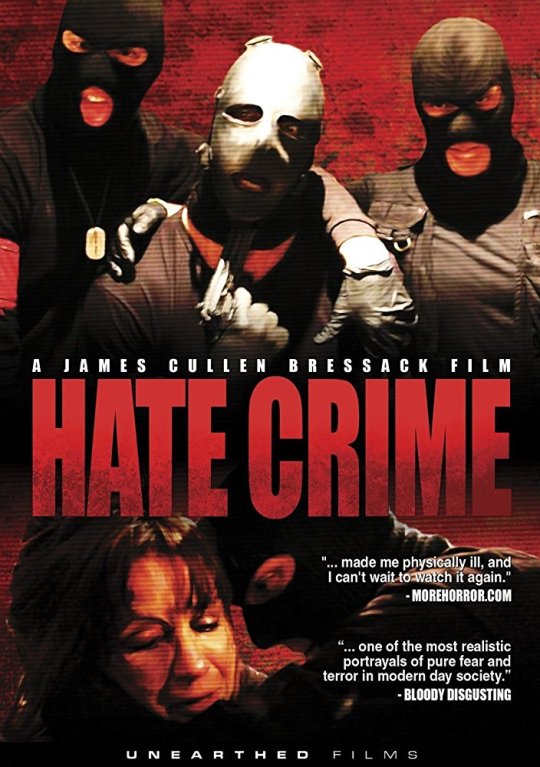
(IMDB, 2012)
Distribution as mentioned before is the selling a product in mass to the public, thus films these days are often subjected to classification by different boards around the world, and the British Board of Film Classification is one of the said organisation. There had being many films being barred from releasing for various reasons. One such film is the 2012 ‘Hate Crime’, which according to the BBFC, includes an excessive amount of abuse of different kinds, and also subtle anti semitism (BBFC, 2015). Of course this wouldn’t stop users from accessing this content. As mentioned before, through the Internet, particularly the Dark Web, users could illegally download the films and thus distributed it to other users in means of online sharing or online streaming.
References:
BBFC, 2015. HATE CRIME. [online] Available at: <http://www.bbfc.co.uk/releases/hate-crime-vod> [Accessed 20 March 2018]
IMDB, 2012, Hate Crime (2012). [online] Available at: <http://www.imdb.com/title/tt2257436/> [Accessed 20 March 2018]
Oxford, 2018. Definition of distribution in English. [online] Available at: <https://en.oxforddictionaries.com/definition/distribution> [Accessed 20 March 2018]
UK Cinema Association, 2018. Film distribution and cinema exhibition. [online] Available at: <https://www.cinemauk.org.uk/the-industry/about-the-uk-cinema-sector/film-distribution-and-cinema-operators/> [Accessed 20 March 2018]
0 notes
Text
TB2- WEEK 1: BLOG 4 - Cinema Management (Part 2: Curzon Cinemas)
This week’s lecture is again based on cinema management, and through out the lecture I gained more insight on managing a for-profit cinema chain, as oppose to a non-profit cinema that was introduced on last teaching block. The lecturer gave some advice on how to start up a small cinema and slowly evolve into a cinema chain, and to be frank those advice could also be applied to my future endeavours.
If I were to start a cinema, factors like the demography of my potential customers and also the geographic positioning of the cinema itself. To maximise profit and increase the chain’s reputation, one must ensure that the customers are always satisfied with the newest films available and also the best cinema experience. I myself find the environment a big factor, since every time I watch a film I tend to be affected by my surroundings, for example with loud and inconsiderate cinema-goers would often ruin my experience.
0 notes
Text
TB1- WEEK 12: BLOG 3 - Working in Film Productions
Even though I do not have plans of getting myself into film productions, it is still very interesting to hear from a professional from the field and to acquire new knowledge regarding how films works. Throughout the lecture I’ve learnt that there is much more going on in the background during a film production, for example there are multiple assistant directors working alongside the directors and the actors. I used to believe that the AD’s job is much more “practical”, such as to help carry the director’s equipment. After the lecture I’ve actually thought of how it would be to be a assistant director for a major film, it could be a fun and stressful experience, especially if people’s hopes are high for a highly anticipated film. I wouldn’t want to ruin the next Star Wars instalment and potentially staining the whole franchise, thus I highly respect those who work behind the scenes for a film.
0 notes
Text
TB1- WEEK 11: BLOG 2 - Introduction to Film & Music Media Copyright
Throughout my course I’ve already written a handful of essays, be it formative or summative, it is all my intellectual properties. Intellectual properties, as defined by the United Kingdom government, is a piece of creative product physically produced by me, I would always own the rights to the piece of content as I’m it’s original content, and thus I have the decision to allow others to use it or not, it is all under my discretion (GOV.UK, 2018).
In order to protect intellectual properties, patents are created as part of a extensive system that allows inventors to sell their creations (British Library, 2018). While patents itself a process which might be time consuming, copyright protections are automatically present on the original content (BBC, 2018).
Of course it is great to know that thieves out there wouldn’t be able to use your content without acknowledging the author. Thus in order to utilise other’s intellectual property for commentary, parody work, criticism. or other proposes, a user could enact the idea of fair use. Fair use means that as long as the content creator utilise the content for purposes other than to gain something from the content that is not rightfully theirs, it is possible to utilise the content without gaining the permission from the original creator, thus protecting users from a copyright infringement (Stanford, 2018). It is worth noting that fair use is mostly a term used in the United States of America, different countries has it own set of laws and thus the terminology might be different, but the idea is still the same.
So why would I use a law from the United States as an example? Because the following case is from the United States itself.
youtube
(h3h3Productions, 2016)
In the lecture and seminar we talked about copyrights on films and musics, and we skimmed the surface of the topic of copyrights on videos and copyright abuse. The above video is from h3h3Productions, a comedy channel dedicated to criticising different events. To sum it all up, Matt Hosseinzadeh, the user on the other end of a criticism, sued h3h3Productions for copyright infringement due to h3h3Productions allegedly “stealing” Matt’s content even though they used Matt’s content for criticism. In the end the court ruled in favour of h3h3Productions as they are under the protection of fair use, thus h3h3Productions won the lawsuit. Through out the course of the lawsuit, it cost h3h3Productions a vast amount of money and time, luckily due to help from other major channels and donations from people, h3h3Productions were able to handle the lawsuit.
With this we could see that copyrighting is not joke, it could potentially cost someone their whole savings. Of course as technology advances, people are more and more aware of copyright laws and the general idea of intellectual properties. But still the question remains, will there be another “h3h3 incident” in the future as the entertainment fields expands? Especially when the users are slowly becoming the creators.
References:
BBC, 2018. What is Copyright?. [online] Available at: <http://www.bbc.co.uk/copyrightaware/what-is> [Accessed 17 March 2018]
British Library, 2018. What is a patent?. [online] Available at: <https://www.bl.uk/business-and-ip-centre/articles/what-is-a-patent> [Accessed 17 March 2018]
GOV.UK, 2018. Intellectual property and your work. [online] Available at: <https://www.gov.uk/intellectual-property-an-overview> [Accessed 17 March 2018]
h3h3Productions, 2016. We're Being Sued. [video online] Available at: <https://www.youtube.com/watch?v=fEGVOysbC8w> [Accessed 17 March 2018]
0 notes
Text
TB1- WEEK 9: BLOG 1 - Regulations of Cyberspace.
Cyberspace, as defined by Oxford, is the universal virtual environment in which computer exchanges information and essentially communicates with each other (Oxford, 2018). With the creation of Internet and increased use in personal computers, more and more users could gain access to the once enigmatic web. And with the public gaining access, there are bound to be rules to restrict users from acquiring some other “forbidden fruits”.
In the lecture and seminar I was briefly introduced to how different countries with their different cultural values and thus corresponding laws regulates the Internet. Mainly a comparison between the regulations on the Internet of the United Kingdom and of course, China and it’s “Great Cyber Wall”. In the comparison, there is a great contrast. United Kingdom allows more freedom to the users while China mainly locks out major websites and creates their own versions of foreign websites.
I’ve also made some comparison after the lecture and seminar. I choose Malaysia as it is my country of origin, Malaysia is a federation in south-east Asia, it was once a colony of the Empire of Great Britain (BBC, 2018). It allows a certain degree of freedom, some regulations are similar to the United Kingdom, but since Malaysia is a country that is under heavy cultural influence, certain regulations would restrict users from accessing. One such rule is prohibiting content that are “obscene” and “indecent”, such as pornography (SBS, 2016)
References:
BBC, 2018. Malaysia country profile. [online] Available at: <http://www.bbc.co.uk/news/world-asia-pacific-15356257> [Accessed 16 March 2018]
Cybersecurity Capacity Portal, 2016. Cyber Related Policies and Laws in Malaysia. [online] Available at: <https://www.sbs.ox.ac.uk/cybersecurity-capacity/content/cyber-related-policies-and-laws-malaysia> [Accessed 16 March 2018]
Oxford University Press, 2018. Definition of cyberspace in English. [online] Available at: <https://en.oxforddictionaries.com/definition/cyberspace> [Accessed 16 March 2018]
0 notes